View in other NatureServe Network Field Guides
NatureServe
Montana
Utah
Wyoming
Idaho
Wisconsin
British Columbia
South Carolina
Yukon
California
New York
Woodland Caribou - Rangifer tarandus caribou
Native Species
Global Rank:
G5T5
State Rank:
SX
(see State Rank Reason below)
Agency Status
USFWS:
USFS:
BLM:
External Links
State Rank Reason (see State Rank above)
Species has declined to extirpation in the state. Transient individuals moving south from Canada have been observed in the past few decades, but none have established populations.
General Description
We do not yet have descriptive information on this species. Please try the buttons above to search for information from other sources.
Species Range
Montana Range
Range Descriptions

 Historical
Historical
Western Hemisphere Range
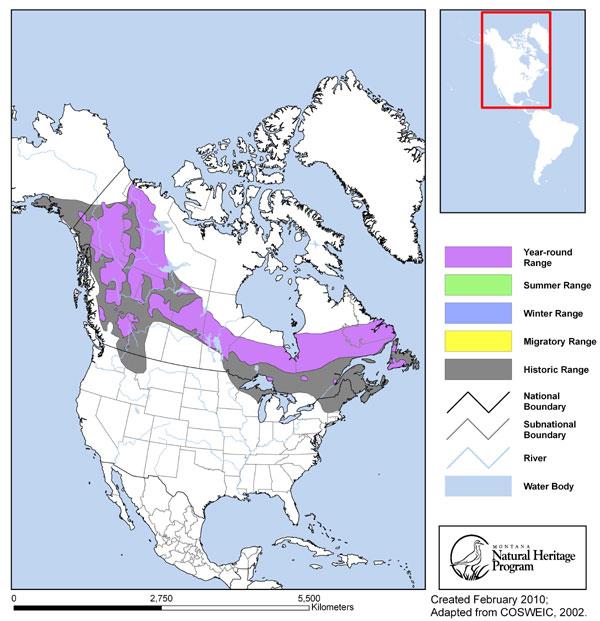
Observations in Montana Natural Heritage Program Database
Number of Observations: 77
(Click on the following maps and charts to see full sized version)
Map Help and Descriptions
Relative Density
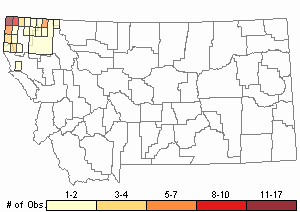
Recency
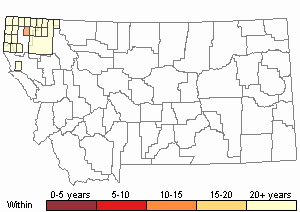
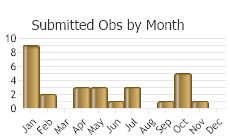
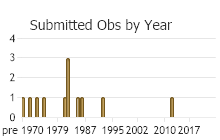
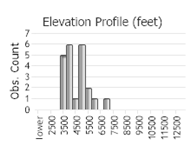 (Observations spanning multiple months or years are excluded from time charts)
(Observations spanning multiple months or years are excluded from time charts)
Habitat
Spring: follow green-up, lower elevations, open timber; females calve at higher elevation slopes and ridges. Summer: mature spruce-fir, north slopes; rut habitat similar, moister, denser. Early Winter: old growth cedar-hemlock. Late Winter: mature subalpine fir.
Food Habits
Winter: arboreal lichens. Spring: forbs and shrubs. Summer: Vaccinium membranaceum and Valeriana sitchensis. Fall and early Winter: evergreen forbs and shrubs and arboreal lichens.
Ecology
26 to 28 caribou in northern ID, southern BC, 3 to 5 calves, 11 to 13 cows, 3 to 10 immature bulls, 3 to 4 mature bulls, cows, calves, immature bulls usually found together in 3.4 groups, mature bulls often more solitary - often move south.
Reproductive Characteristics
Selkirk herd raised 3 calves 1982 and 84, 5 calves in 1985. Calving second week of June at high elevations; high early calf mortality, maybe as high as 50 to 75% annually. Rut mid-September to October.
Stewardship Responsibility
References
- Additional ReferencesLegend:
 View Online Publication
View Online Publication
Do you know of a citation we're missing? Anonymous. 1953. Caribou on the Yaak. Montana Wildlife. August.
Anonymous. 1953. Caribou on the Yaak. Montana Wildlife. August. Bergerud, A.T. 1973. Movement and rutting behavior of Caribou (Rangifer tarandus) at Mount Albert, Quebec. Canadian Field-Naturalist 87:357-369.
Bergerud, A.T. 1973. Movement and rutting behavior of Caribou (Rangifer tarandus) at Mount Albert, Quebec. Canadian Field-Naturalist 87:357-369. Cameron, R.D. 1994. Reproductive pauses by female caribou. Journal of Mammalogy 75(1):10-13.
Cameron, R.D. 1994. Reproductive pauses by female caribou. Journal of Mammalogy 75(1):10-13. Chadwick, D.H. 1982. Caribou south of the border? National Wildlife 20(5):40-42.
Chadwick, D.H. 1982. Caribou south of the border? National Wildlife 20(5):40-42. Child, K.N. 1980. Caribou in British Columbia. Province of British Columbia, Ministry of the Environment Informational Pamphlet. 4 p.
Child, K.N. 1980. Caribou in British Columbia. Province of British Columbia, Ministry of the Environment Informational Pamphlet. 4 p. Drumheller, S. Biologists losing battle to save dwindling caribou. Coeur d'Alene and Sandpoint, ID: The Spokesman Review.
Drumheller, S. Biologists losing battle to save dwindling caribou. Coeur d'Alene and Sandpoint, ID: The Spokesman Review. Drumheller, S. Caribou herd up for adoption. Coeur d'Alene, ID: The Spokesman-Review. 27 August 2000. p. A8.
Drumheller, S. Caribou herd up for adoption. Coeur d'Alene, ID: The Spokesman-Review. 27 August 2000. p. A8. Evans, H.F. 1960. A preliminary investigation of caribou in northwestern United States. M.S. thesis. University of Montana, Missoula. 145 pp.
Evans, H.F. 1960. A preliminary investigation of caribou in northwestern United States. M.S. thesis. University of Montana, Missoula. 145 pp. Evans, H.F. 1964. An investigation of woodland caribou in northwestern United States. North American Wildife and Natural Resources Conference 29:445-453.
Evans, H.F. 1964. An investigation of woodland caribou in northwestern United States. North American Wildife and Natural Resources Conference 29:445-453. Foresman, K.R. 2012. Mammals of Montana. Second edition. Mountain Press Publishing, Missoula, Montana. 429 pp.
Foresman, K.R. 2012. Mammals of Montana. Second edition. Mountain Press Publishing, Missoula, Montana. 429 pp. Gebrke, C. 1982. Prognosis gloomy for Idaho caribou. High Country News 14(21).
Gebrke, C. 1982. Prognosis gloomy for Idaho caribou. High Country News 14(21). Helena Independent Record. Are caribou hiding in the hills? Helena, MT: Independent Record. 15 February 1983.
Helena Independent Record. Are caribou hiding in the hills? Helena, MT: Independent Record. 15 February 1983. Helena Independent Record. No trace of caribou found in northwest Montana search. Helena, MT: Independent Record. 30 April 1986.
Helena Independent Record. No trace of caribou found in northwest Montana search. Helena, MT: Independent Record. 30 April 1986. Hoffmann, R.S. and D.L. Pattie. 1968. A guide to Montana mammals: identification, habitat, distribution, and abundance. Missoula, MT: University of Montana. 133 p.
Hoffmann, R.S. and D.L. Pattie. 1968. A guide to Montana mammals: identification, habitat, distribution, and abundance. Missoula, MT: University of Montana. 133 p. Jerry, D. 1984. Selkirk Mountain caribou management plan/recovery plan. Portland, OR: U.S. Fish Wildlife Service, Idaho Panhandle NF. 121 p.
Jerry, D. 1984. Selkirk Mountain caribou management plan/recovery plan. Portland, OR: U.S. Fish Wildlife Service, Idaho Panhandle NF. 121 p. Joslin, Gayle, and Heidi B. Youmans. 1999. Effects of recreation on Rocky Mountain wildlife: a review for Montana. [Montana]: Montana Chapter of the Wildlife Society.
Joslin, Gayle, and Heidi B. Youmans. 1999. Effects of recreation on Rocky Mountain wildlife: a review for Montana. [Montana]: Montana Chapter of the Wildlife Society. Manley, T.L. 1986. Status review of woodland caribou in Montana. Montana Department of Fish, Wildlife and Parks. Final Progress Report. 84 p.
Manley, T.L. 1986. Status review of woodland caribou in Montana. Montana Department of Fish, Wildlife and Parks. Final Progress Report. 84 p. Miller, D.R. 1977. Feasibility of reintroducing caribou in Glacier National Park [1976 progress report]. P. 49 in K. L. McArthur, comp., 1976 Annual Research Summary, Glacier National Park. USDI National Park Service, Glacier National Park. 64 pp.
Miller, D.R. 1977. Feasibility of reintroducing caribou in Glacier National Park [1976 progress report]. P. 49 in K. L. McArthur, comp., 1976 Annual Research Summary, Glacier National Park. USDI National Park Service, Glacier National Park. 64 pp. Miller, D.R. 1977. The feasibility of reintroducing caribou in Glacier National Park: a preliminary study. Unpubl. Rep. 16 pp.
Miller, D.R. 1977. The feasibility of reintroducing caribou in Glacier National Park: a preliminary study. Unpubl. Rep. 16 pp. National Audubon Society Newsletter. Truce calms Idaho caribou conflict. New York, NY: NAS Newsletter. June 1986. p. 3.
National Audubon Society Newsletter. Truce calms Idaho caribou conflict. New York, NY: NAS Newsletter. June 1986. p. 3. Nelson Jr., L. and W. Baker. The woodland caribou: bigfoot of the Selkirks. Moscow, ID: USDA Forest Service and Dept. of Fish and Wildlife Resources. Pamphlet.
Nelson Jr., L. and W. Baker. The woodland caribou: bigfoot of the Selkirks. Moscow, ID: USDA Forest Service and Dept. of Fish and Wildlife Resources. Pamphlet. Peterson, R. L. 1966. The mammals of eastern Canada. Oxford University Press. Toronto, Canada. 465 pp.
Peterson, R. L. 1966. The mammals of eastern Canada. Oxford University Press. Toronto, Canada. 465 pp. Rominger, E. 1990. Research continues on augmentation of the southern Selkirk Mountain caribou herd. Endangered Species Technical Bulletin 15(8):1.
Rominger, E. 1990. Research continues on augmentation of the southern Selkirk Mountain caribou herd. Endangered Species Technical Bulletin 15(8):1. Scott, M.D. and G. Servheen. 1985. Caribou ecology. Idaho Department of Fish & Game. Job completion report Project #W-160-R-12. 136 p.
Scott, M.D. and G. Servheen. 1985. Caribou ecology. Idaho Department of Fish & Game. Job completion report Project #W-160-R-12. 136 p. Servheen, G. and L.J. Lyon. 1989. Habitat use by woodland caribou in the Selkirk Mountains. The Journal of Wildlife Management. 53(1): 230-237.
Servheen, G. and L.J. Lyon. 1989. Habitat use by woodland caribou in the Selkirk Mountains. The Journal of Wildlife Management. 53(1): 230-237. Stephenson, R.O., D.V. Grangaard and J. Burch. 1991. Lynx, Felis lynx, predation on red foxes, Vulpes vulpes, caribou, Rangifer tarandus, and Dall sheep, Ovis dalli, in Alaska. Can. Field-Nat. 105:255-262.
Stephenson, R.O., D.V. Grangaard and J. Burch. 1991. Lynx, Felis lynx, predation on red foxes, Vulpes vulpes, caribou, Rangifer tarandus, and Dall sheep, Ovis dalli, in Alaska. Can. Field-Nat. 105:255-262. USFWS. 1986. Proposed Rules List of Animal Petition Findings. Federal Register 51(6):997.
USFWS. 1986. Proposed Rules List of Animal Petition Findings. Federal Register 51(6):997.
- Web Search Engines for Articles on "Woodland Caribou"
- Additional Sources of Information Related to "Mammals"





